Slate Creek Divide Area
Fast Flight Facts
Target Species: Black-chinned Sparrow, Gray Vireo, Scott's Oriole and other chaparral/juniper species; Dusky-capped Flycatcher, Mexican Jay and other Pine/Fir/Oak/Sycamore species in Transition Zones
Elevation: 4000' through 6200'
Habitat: Chaparral and juniper covered slopes in lower elevations, drainages with ponderosa pine, Douglas fir, sycamores and oaks in Transition Zones
Overall Birding Rating: 5 (Top 10 Maricopa County Hotspot)
Difficulty: 3-5 (Moderate to Very Difficult)
Birding Type: Moderate to Difficult Hiking, Bushwhacking
Facilities: None; Convenient pull offs for camping overnight
Fees/Ownership: No fees, part of the Tonto National Forest
Closest Town or City/How far from Phoenix: Sunflower is the closest town, Slate Creek is 50 miles northeast of Phoenix
Getting there: Accessed from Highway 87 by a hard-packed dirt road that leads to high elevation forests
Overview: Despite suffering from two major wildfires: the Willow Fire in 2004 and the Sunflower Fire in 2012, the Slate Creek Divide Area in the northeastern part of Maricopa County is one of the best birding places in the county, where the unexpected may show up. Adjacently accessed from Mount Ord up through Forest Road 201, the Slate Creek Divide area offers great high elevation forests as well, but with a different mix of habitat. Douglas fir is dominant here, and is joined by ponderosa pine and oak. In some of the area's dense drainages, these conifers and oaks are also joined by extensive sycamore trees. This combination creates a habitat wonderfully similar to the canyons and mountain ranges in southeastern Arizona. Just like Mount Ord, the Slate Creek Divide Area is intercepted with the Maricopa and Gila County lines, crossing over each other many times. The best birding Slate Creek has to offer in the Maricopa County side come from a few drainages that run south, which require very careful hiking in hazardous areas that should not be explored alone.
Slate Creek Divide is known for having local rarities in the higher elevation conifer forests. These rarities have included Spotted Owl, Flammulated Owl, Northern Saw-wet Owl, Mexican Jay, Dusky-capped Flycatcher, and Red-faced Warbler. A remarkable Elegant Trogon was even found here once (T. Corman). Some of these species have declined in the area after a devastating fire, but may be around. Spotted Owl, Flammulated Owl, and Northern Saw-whet Owl have been detected again, and are once again confirmed in the area in recent times. Mexican Jays highly favor Slate Creek Divide, and are harder to find in the county's transition zones elsewhere. In one of the Maricopa County drainages with good sycamore/conifer habitat, breeding Dusky-capped Flycatchers were found in 2010 and have been present since. It was the first time this southeastern Arizona flycatcher was found breeding in Maricopa County. Historically, Red-faced Warblers once nested at Slate Creek Divide, but declined in the area and haven't been confirmed as nesting in the county again after the 2004 Willow Fire. There is still good habitat for the Red-faced Warbler in a few places if it ever decides to return again as a breeder. Thus, the Red-faced Warbler may be found in the area as a migrant for a lucky birder. The mix of sycamore, oak, Douglas fir, and ponderosa pine in the Maricopa County drainages offer great potential to attract higher elevation rarities on a Maricopa County scale and should be explored thoroughly. Look on the "maps" section of this page to get an overview of where to hike in these special drainages.
Quite similar overall in ways to the bird life of Mount Ord, similar species may be observed in both the lower slopes as well as the forests. Starting at and continuing up Forest Road 201 and passing through the lower slopes before reaching the higher elevations, both Gray Vireos and Black-chinned Sparrows may be observed, as well as Scott's Orioles, Canyon Towhees, and Rufous-crowned Sparrows. By spending several minutes listening and observing, these species will usually be located rather easily.
Once in the higher forest habitats, look and listen for breeders in Zone-tailed and Cooper's Hawks, Northern Pygmy-Owl, Anna's and Broad-tailed Hummingbirds, Acorn and Hairy Woodpeckers, Northern "Red-shafted" Flicker, Western Wood-Pewee, Dusky-capped and Ash-throated Flycatchers, Plumbeous and Hutton's Vireos, Western Scrub-Jay, Bushtit, Bridled Titmouse, Red and White-breasted Nuthatches, Brown Creeper, Bewick's and House Wrens, Blue-gray Gnatcatcher, Hermit Thrush, Olive, Virginia's, Black-throated Gray, and Grace's Warblers; Painted Redstart, Spotted Towhee, Hepatic and Western Tanagers, Black-headed Grosbeak, and Red Crossbill (sometimes).
Birds to expect during migration and at times throughout the year include Rufous Hummingbird, Olive-sided, Hammond's, Gray, Dusky, and Cordilleran Flycatchers; Warbling Vireo, Steller's and Mexican Jays, sometimes Pygmy Nuthatch, Ruby-crowned Kinglet, Western Bluebird, Orange-crowned, Yellow-rumped, Townsend's, Hermit, Red-faced (with some luck!) and Wilson's Warblers; Green-tailed Towhee, Lazuli and Indigo Buntings, and Pine Siskin.
Birding Tip: First and foremost importantly, do not ever come and explore this area alone. Exploring Slate Creek's best birding spots involves hiking in hazardous drainages where a combination of hiking down steep slopes with loose rocks the entire way, rattlesnakes, bears, mountain lions, and limited cell phone signal is the perfect reason why exploring in groups is important. To have good birding success in Maricopa County at Slate Creek Divide, go and explore the areas I have given visual directions to under the section "Pages" on this page, under maps. Directions are provided with tips on routes and finding a few of the rare in Maricopa County birds, such as the Dusky-capped Flycatcher.
Directions: The access point of Slate Creek Divide is reached along the Highway 87 (Beeline Highway) just north of milepoint 222, by taking the turnoff to Sycamore Creek to the west (adjacent to the Mount Ord turnoff to the east). This turnoff is about 35 miles north of where Shea Blvd. meets the Highway 87, as Shea Blvd. is a popular access point when taking the Beeline Highway anytime. Once turning on the Sycamore Creek turnoff, this is actually part of the Old Beeline Highway. After driving west for 1.2 miles on the Old Beeline Highway, you will come across a dirt road turnoff that goes in the northeast direction, which is Forest Road 201. Take this road to the higher elevation forests, which is close to ten miles in length. Forest Road 201 is in decent condition, and is drivable for most vehicles. It only has a few rough patches throughout the road's duration. For visual directions, see the Slate Creek Divide Area Maps on this page under the "Pages" section.
Pages:
Scenes and Sights from the Slate Creek Divide Area:
The sad result of human caused fires
Lower slopes of the Slate Creek Divide Area
Birdlife of the Slate Creek Divide Area:
Common Poorwill
Dusky-capped Flycatcher-rare in Maricopa County (Slate Creek Divide holds a local breeding population)
Mexican Jay-rare in Maricopa County (Slate Creek holds a local breeding population)
Mexican Spotted Owl-very rare and local in Maricopa County. It is also a federally threatened species. Do not use playback at night to call this bird in. If it's found during the day, don't use flash photography, don't get too close to it, and don't linger in it's area for too long.
Western Wood-Pewee
Painted Redstart
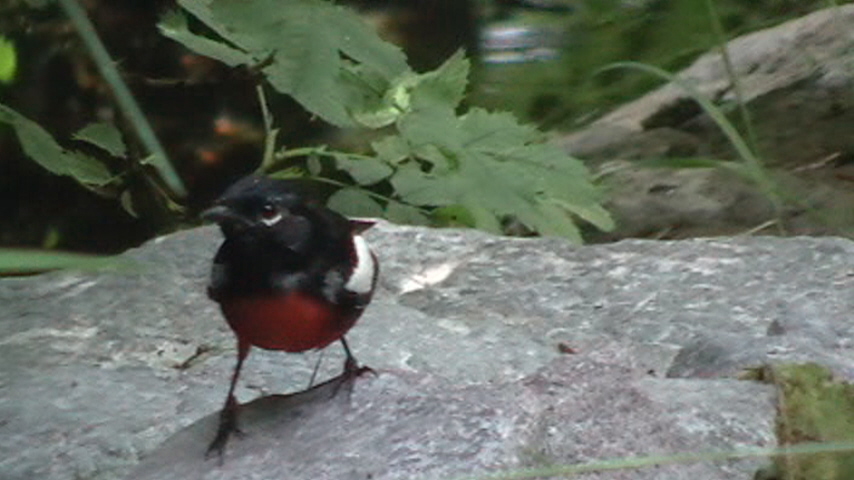
Brown Creeper
Red-faced Warbler (Poor but diagnostic photo) Formerly a breeder, now just known as a scarce migrant in the county

Bridled Titmouse
Broad-tailed Hummingbird
Bushtit
Slate Creek Divide Area Maps
*All maps owned by Google
Welcome to the Slate Creek Divide Area. These directions will help you find the areas to bird in the better spots this location has to offer, and will increase your birding luck.
Map #1-Turnoff Overview when accessing the Slate Creek Divide Area
Turnoff Overview: This map illustrates the turnoff to access the Slate Creek Divide Area. When coming north or southbound up or down Highway 87 (Beeline Highway), the turnoff to the Slate Creek Area is located just north of mile marker 222 on the highway. Here a turnoff will be seen that is marked for both Sycamore Creek (a turn to the west) as well as Mount Ord (turn to the east). After taking the Sycamore Creek turnoff west, the paved road is part of the Old Beeline Highway (highlighted in LIME-GREEN). Follow the Old Beeline Highway west for 1.2 miles until a noticeable dirt road is seen that heads in the northeast direction. This is Forest Road 201. Take this dirt road for 9.7 miles to it's ending point at the Mount Peeley Trailhead, which is part of the Arizona trail. One will start to access the Transition Zone at about 6.7 miles while driving on this road As shown, Forest Road 201 is the IVORY-COLORED path. Gray Vireos, Black-chinned Sparrows, Scott's Orioles, and Crissal Thrashers may be viewed from this beginning stretch.
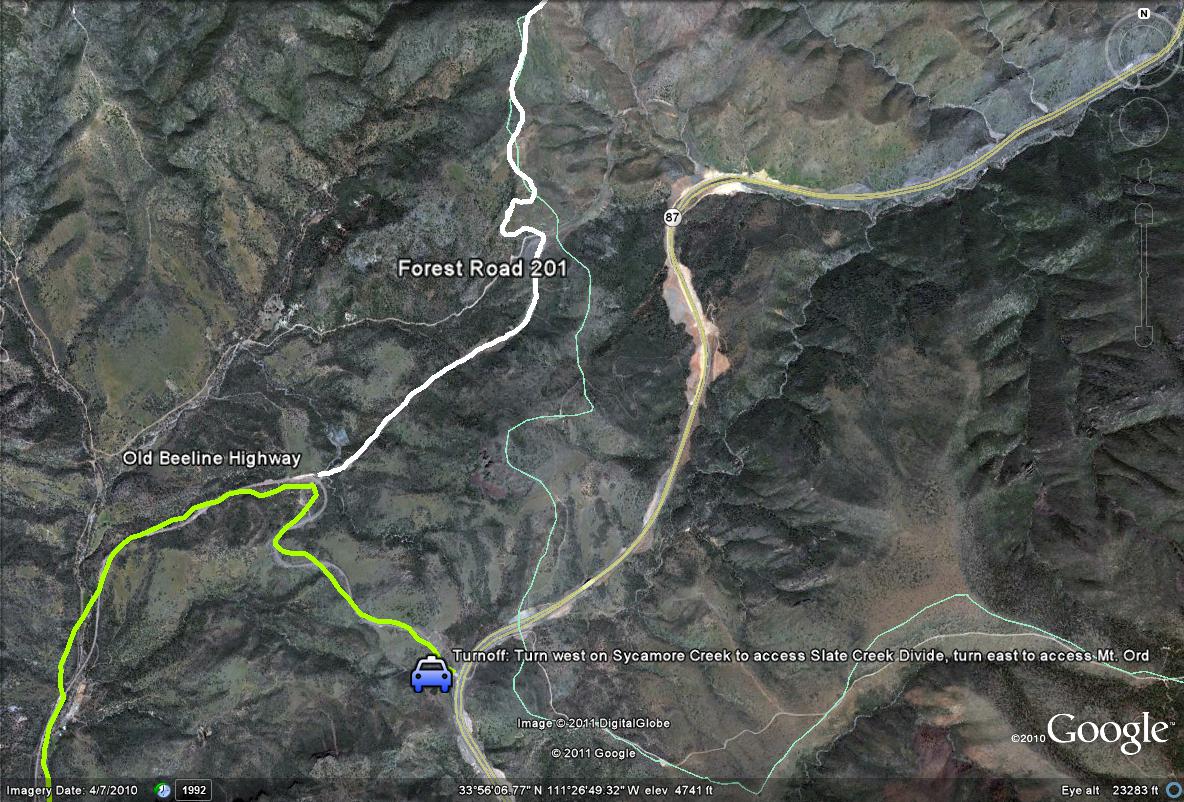
Map # 2: Overall directions of driving through the Slate Creek Divide Area
As mentioned on Map 1, take the Sycamore Creek turnoff west from Highway 87 just north of mile marker 222. Once turning off, the paved road one is on is the Old Beeline Highway. Follow the Old Beeline Highway west for 1.2 miles. Look for a dirt road turnoff on the right side of the road, which is heading in the northeastern direction. Turn right/northeast on this road. This is Forest Road 201. Follow Forest Road 201 for up to 9.7 miles, where it dead ends at the Mount Peeley Trailhead. This trailhead is also part of the Arizona Trail. When driving up on Forest Road 201 towards the Mount Peeley Trailhead, watch for other side roads that branch off to the left. There are three of them. As these side roads meet Forest Road 201, they are always on the left. Just remember to keep right on the main road at this point at all times. These three left side roads are found roughly at miles 1.2, 3.5, and 5.2. Continuing on Forest Road 201, one will reach the Transition Zone and come into contact with pine trees at 6.7 miles. For the last three miles of Forest Road 201, it passes through patches of good mixed conifer and oak forest. At mile marker 7.7, one will come into contact with Forest Road 201-A, a side "road" that heads south into Maricopa County. See maps below this map for more information.
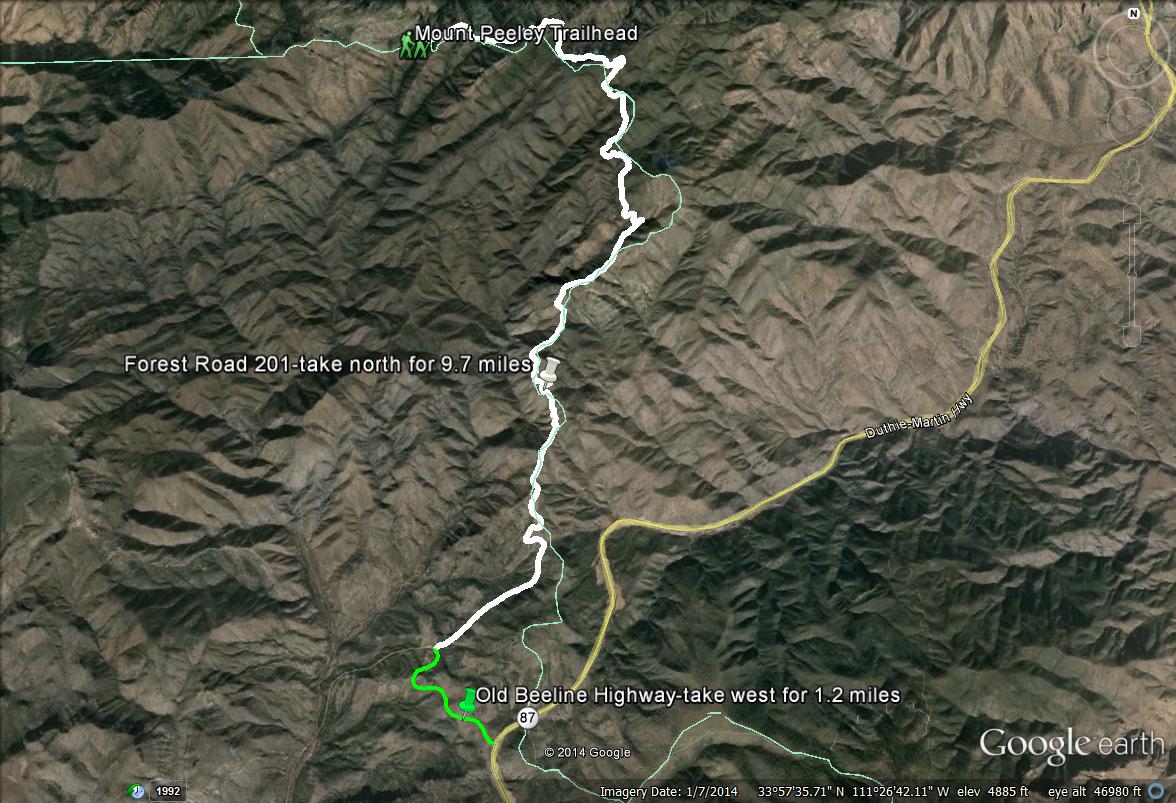
Slate Creek's Transition Zone areas that are in Maricopa County:
Slate Creek Divide is mostly in Gila County once the Transition Zone is reached. Most of Forest Road 201 is in Gila County after the 6 mile mark. Maricopa County is always close to this road, however. The Gila County side has outstanding birding in the burned and live patches of Douglas fir forest along the road also. For the Maricopa lister, one will have to get themselves in for more serous hiking.
Map #3: Forest Road 201-A
Once driving up Forest Road 201 for a good distance and reaching the spot where the good forest habitat really starts to begin, one will soon come across a side road that is accessed from FR 201, that is named Forest Road 201-A. This road is entirely Maricopa County just after entering the road a short distance. This road's surrounding habitat was burned by the Sunflower Fire in 2012 and used to be an excellent birding spot. Despite the fact most of it has been burned, it still passes through good forest habitat in places, especially within the first 1/4 mile. There is a stand of pines here at the beginning, which is good for pine loving species such as Grace's Warbler, Hepatic Tanager, and more. Further down the road south about a half mile to 3/4 mile, is another stand of pines. Forsest Road 201-A continues on for a good distance past the forest habitat, heading in the southwest direction. Chaparral and juniper species may be observed along this road also. The best birding along this road takes place within the first mile of walking. The hike has a few minor climbs and drops in elevation on the road, but is otherwise pretty flat. Also, great views of the surrounding Slate Creek area and Mazatzal Mountains are viewed nicely from this road!
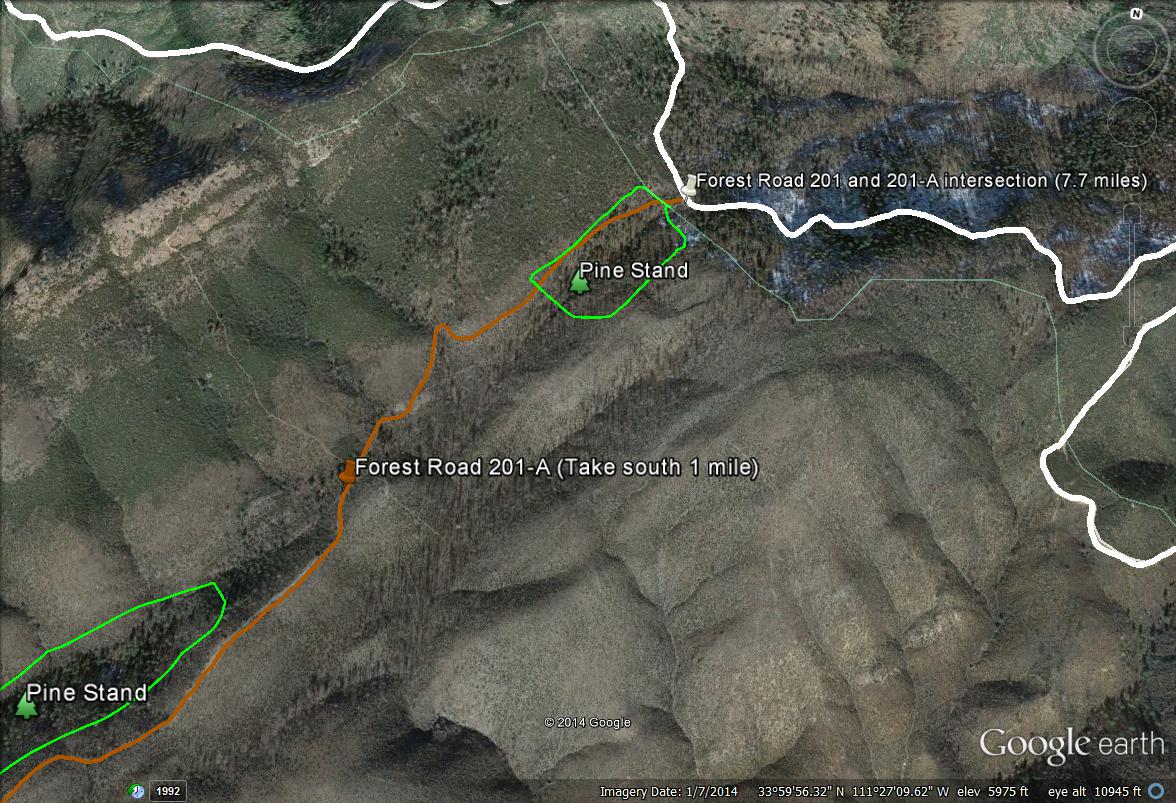
Map # 4: Some of Maricopa's best habitat: the two Slate Creek Divide drainages south of the Peeley Trailhead
This map shows two drainages at Slate Creek Divide that hold some of the very best habitat that is to be found in Maricopa County. In the 2012 Sunflower Fire, the fire burned around the drainages, but luckily, it didn't touch these two drainages at all. Both drainages hold a significant breeding population of Dusky-capped Flycatchers, which is currently Maricopa County's only known breeding location for this species. Dusky-capped Flycatchers mainly range in the southeastern part of Arizona, but are expanding their range northward in several areas of central Arizona. Like southeastern Arizona, these two Maricopa County drainages hold very similar habitat makeups that include Douglas fir, ponderosa pine, oak, and Arizona sycamore. With this habitat selection, the potential is very high for unusual birds in the Maricopa County region. This drainages are also very good for viewing Mexican Jay, another species that is scarce in the county. With the Douglas fir habitat (the most dominant tree in here), these drainages hold breeding habitat for Red-breasted Nuthatch and Brown Creeper also, which don't breed elsewhere in the county. Spotted Owl and Red-faced Warbler have also been found, and may potentially breed in these drainages now or in the future.
To see these birds and habitat, one needs to hike down the drainages, and they are accessed directly south from the Mount Peeley/Arizona Trail trailhead. The hike is challenging to very difficult, as one will have to climb over logs and rocks in places. There are plenty of hazards in the area (see below). The first drainage, Drainage A, is the one that is accessed from the Trailhead. It heads south for 0.9 miles and ends at the other drainage, which is titled Drainage B. In the 0.9 miles, Drainage A is a fairly difficult hike, but it can be handled by a majority of people. There are steep climbs over rocks and bushwhacking spots in a few places, but it is otherwise a gradual walk down for the 0.9 miles to Drainage B. Once Drainage B is reached, one has two options at the fork of both drainages. One is to head south down Drainage B, and the second is to head north up Drainage B. If one is in for the adventure, it is a good idea to take both, starting with going south for up to a half mile down Drainage B. There are good stands of Arizona sycamore along this stretch in midst of fir, pine, and oak. The good habitat starts to end and the hiking gets a lot more rough as one hikes almost a half mile south of the fork down Drainage B. If hiking up Dranage B north of the fork for both Drainages, the drainage may be followed for close to a mile. Like Drainage A, taking Drainage B north of the forks is more of a pleasant but still challenging walk for the first half mile but the latter half is very difficult. Halfway down this stretch, the habitat gets a lot more steep, thick, slippery, and is much more hazardous. If hiking here, be very careful. If hiking to the very northeastern limit of Drainage B, one may have an easier way to climb up and out of the drainage to quickly access Forest Road 201. On Forest Road 201 at this point, it is only a half-mile walk back west to the Peeley Trailhead. See the next map, Map # 5, for a better overview. A third option would be to hike down Drainage A to the fork of both drainages, and then take Drainage B both north and south of the fork for shorter distances. Once taking Drainage B both ways for short distances from the fork, then one can return to the fork and head back up Drainage A to the Trailhead and parking area. For a grand tour and challenging hike of both drainages in hiking loop fashion, see Map # 6.
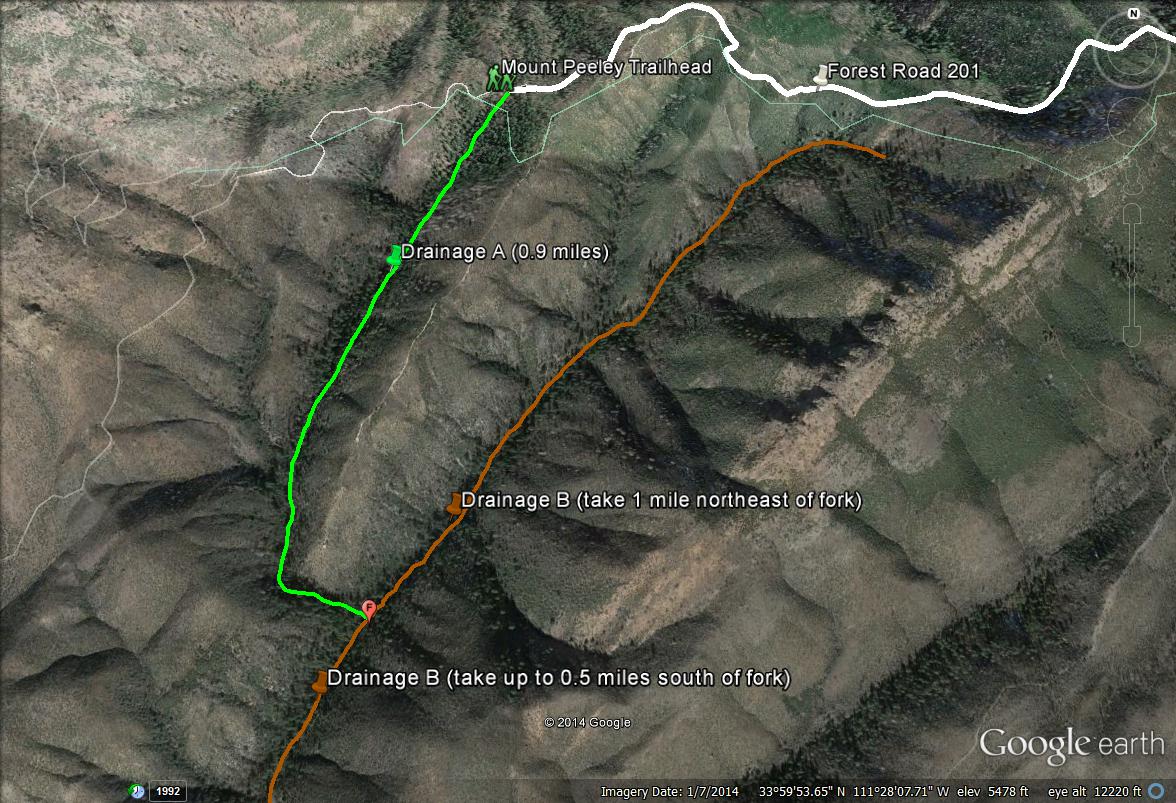
SLATE CREEK DUSKY-CAPPED FLYCATCHER FACTS AND TIPS: The Dusky-capped Flycatchers were discovered in August of 2010 near the fork of the two Drainages, but south of the fork in Drainage B. They were seen later that week feeding young, to confirm breeding in the county. The first year saw about ten birds. The following year in 2011, they were detected in good numbers again, with 7 individuals in May. They were at the southern end of Drainage A, at the fork, and south of the fork in Drainage B. In 2012, they went undetected due to the Sunflower Fire and closed access to Slate Creek. In 2013, numbers were very high, and 16-18 individuals were counted in July. They were at the fork and then oddly north of the fork and well spread out up Drainage B. 2014 then saw about 8 birds in May, at the south side of Drainage A, at the fork, and in Drainage B shortly south of the fork. There are likely 4 to 5 pairs of these flycatchers in the drainages annually, and the number of young fledged is an interesting thought too. Overall, the best place to get a Maricopa County Dusky-capped Flycatcher here would be to hike down to the area of the fork. The mournful song of the flycatcher can't be missed!
HAZARDS: The drainages at Slate Creek are a very tiring and exhausting hike. Bring plenty of food and water. Don't take life for granted here, never come down these drainages alone. There are spots were the habitat is very thick and hard to get around and will scratch people up a bit. Sections of the hike are rocky and canyon like with loose rocks in many places, making it an easy place to slip and fall. Dangerous wildlife includes Rattlesnakes (in abundant numbers), Black Bears, Mountain Lions, Scorpions, as well as Poison Ivy. Cell phone signal is usually dead down in the drainages as well. On a positive note, cell phone signal can usually be very good from Forest Road 201, depending on what service is used. The picture below is of a Black-tailed Rattlesnake in Drainage B, south of the fork.
Map # 5: Climbing out of the northeastern section of Drainage B
If walking to the very northeastern section of Drainage B, one has a convenient and much quicker route to get out of the drainages. One will know when Drainage B is reaching it's ending point. There is a horrible stretch of habitat to bushwhack through before the very last stretch. Towards the end, there are steep climbs in the area of the drainage but it isn't as thickly vegetated everywhere. Once one comes close to the end, the drainage will go upward. Follow it upward a short distance. If looking northwest, Forest Road 201 may be seen a very short distance away. The problem is is that there is thick chaparral habitat between the drainage and road. By studying this map or having a GPS, there is a steep but do-able climb up to the east of the drainage up to a ridge that leads to a trail. By climbing up this way, the vegetation isn't as thick as a straight shot up to Forest Road 201 through chaparral. The chaparral will cut a person up very badly. By walking up to this east ridge from the drainage, it saves energy and horrible bushwhacking. Once the trail is found, take it down to the north and back to Forest Road 201. From here, it is about a half-mile walk west to the Mount Peeley Trailhead.
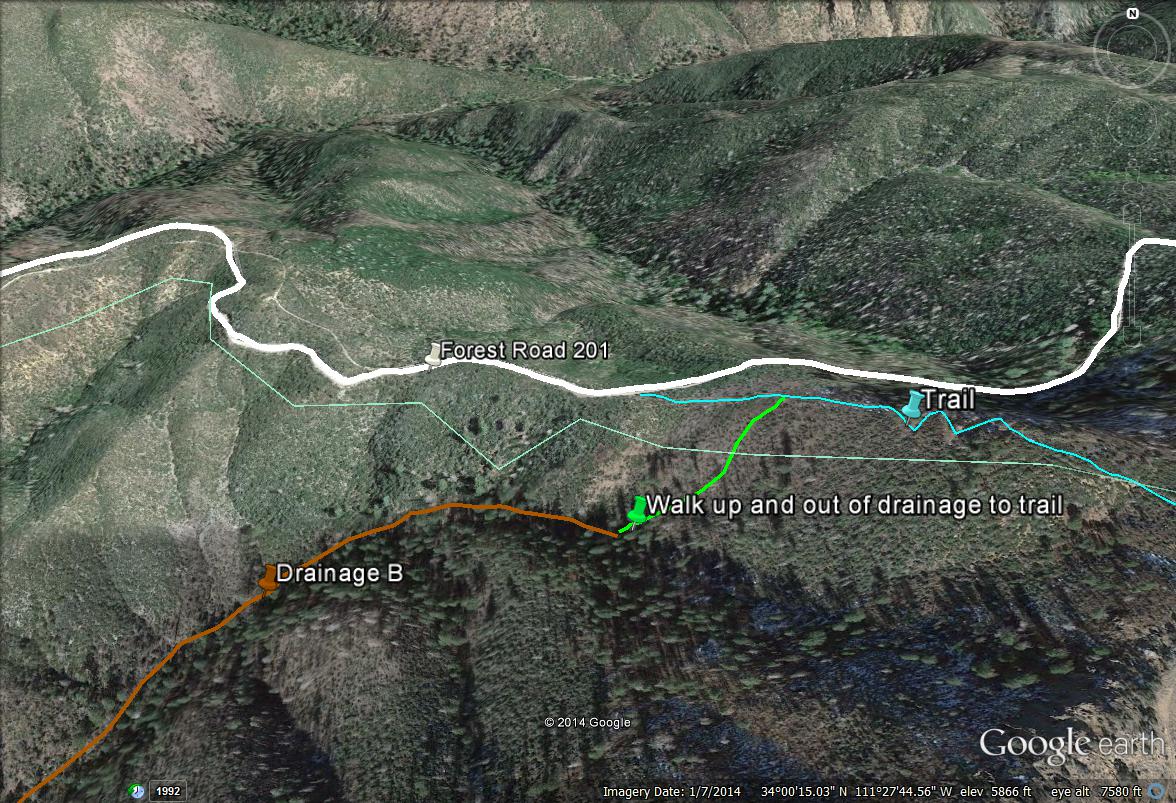
Map # 6: Complete Drainage A and B loop hike
This hike is long and tiring, but the birding is very rewarding. Refer to maps 4 and 5 for this loop also. It helps to be familiar with the area also when trying to hike this loop. Once parking at the Peeley Trailhead, take Drainage A south for the 0.9 miles. Once at the fork of the two drainages, take Drainage B for a distance (probably 0.5 miles at the most) south past the fork. Once completing it, head back north and past the fork. Then, work the rest of Drainage B for a mile north past the forks. When reaching the eastern limit of Drainage B, take the suggested route out of Drainage B as illustrated on Map 5 back to Forest Road 201. Once on Forest Road 201, walk about a half mile west back to the Peeley Trailhead. Altogether, this loop hike is about 3.3 miles. It's not a long distance, but the bushwhacking and climbing make it feel like a much longer hike. On the map below, the yellow line illustrates the loop hike.
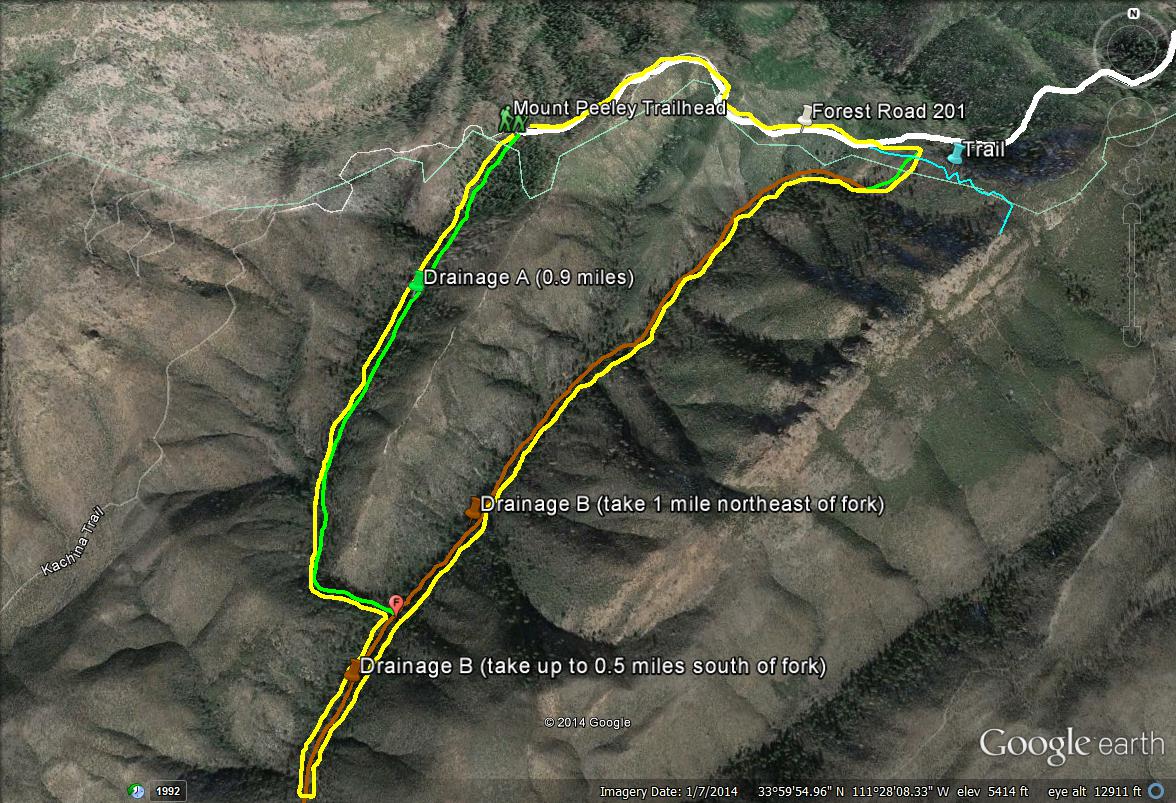
No comments:
Post a Comment